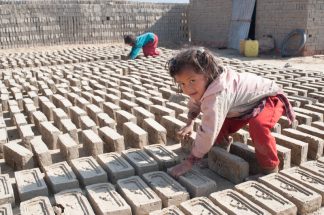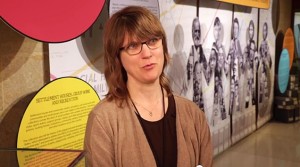By Allison Campbell-Jensen
David Parker has been taking photos of child labor for more than three decades. An occupational medicine physician affiliated with the Environmental Health Sciences Program at the University of Minnesota School of Public Health, Parker began researching young workers in Minnesota and subsequently began photographing them in Mexico. He has since traveled the world documenting the lives of working children in factories and fields, in streets and in homes. He deposits all his photos and papers in our Social Welfare History Archives.
History Professor M. J. Maynes and Public Affairs Professor Deborah Levison combed through Parker’s images in the University of Minnesota Libraries’ Social Welfare History Archives to curate the exhibit Seeing Child Labor through the Photography of David L. Parker. They were motivated by their involvement in the interdisciplinary research circle Children and Youth as Subjects, Objects, Agents: Lives and Livelihoods in the Global South and historically. The resulting images of toddlers moving bricks, children begging, and youngsters carrying loads in mines, are searing, startling, and saddening. Yet a girl finds a toy in her dump scavenging, other children study, and a teen works at the State Fair.
Their exhibit was displayed in the Elmer L. Andersen Library starting in February 2020. When the building closed in March due to COVID, so did opportunities to view it — for a while. The Seeing Child Labor exhibit re-emerged in an online format. And developing this online exhibit examining children’s agency in work ended up empowering recent graduates from the U.
Rising to the challenge
“[This exhibit] is an example of how partnerships between Archives and Special Collections and an academic program are opportunities to advance student learning and professional development as well as create engaging content for outside audiences,”
—Linnea Anderson
In the summer of 2020, Simiyha Garrison had just earned her master’s degree from the Heritage Studies and Public History program and became the project manager for this conversion to an online exhibition. “There was a lot of pressure,” she says. It was a new dynamic for her to have interns reporting to her and for her to be reporting to a supervisor. “Yet I found I could do this as a profession, I could work as a consultant, I could consult digitally.” She finds the result satisfying and is glad to have contributed to a resource on this relevant global issue.
Her colleague Elisabeth DeGrenier, who also graduated from Heritage Studies and Public History, was primarily responsible for supporting Simiyha in creating the website. She also helped develop the teacher’s guide and digital educational resource to accompany the online exhibit. DeGrenier says she’s proud of the results and she really enjoyed the collaboration with Garrison, Parker, and the interns.
Parker met with Garrison and DeGrenier weekly. He helped with editing text and organizing the photographs. “We worked together to think about flow,” he says, “what images follow the other ones in a more cohesive fashion — the curatorial role.”
He adds: “I think they did a terrific job.”
Building the collections
Linnea Anderson, Archivist of the Social Welfare History Archives, has witnessed the evolution of the exhibit. “It’s an example of how partnerships between Archives and Special Collections and an academic program (in this case Heritage Studies and Public History) are opportunities to advance student learning and professional development as well as create engaging content for outside audiences,” she says.
The history of children’s work and those who sought and seek to expose it is an important collecting area for the Social Welfare History Archives, Anderson says. Parker’s images are a significant addition to that collection.
She adds: “From an artistic perspective, these are very impactful images of children’s lives and work. I feel that the often direct look from the child who is returning the viewer’s gaze can be very powerful.”






